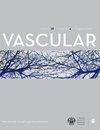冷冻保存的尸体大隐静脉与拼接自体静脉用于腹股沟下搭桥术的效果比较
IF 1
4区 医学
Q4 PERIPHERAL VASCULAR DISEASE
引用次数: 0
摘要
目的当没有单段自体大隐静脉时,冷冻保存的大隐静脉(CV)和拼接的自体静脉(SV)可作为下肢血管再通术的替代导管。本研究比较了使用 CV 和双节段 SV 作为导管进行腹股沟下旁路手术的结果。方法我们对本机构所有使用 CV 或 SV 进行下肢旁路手术的数据进行了回顾性回顾。因动脉粥样硬化性闭塞症而接受血管再通手术的患者被纳入统计分析范围,而原发性急性栓塞和/或创伤性原因导致的患者则被排除在外。主要结果包括肢体缺失。次要结果包括1年和3年后的主要、主要辅助和次要通畅率。结果56名患者被纳入分析,其中25人进行了CV搭桥,31人进行了SV搭桥。除年龄(平均年龄 68 CV vs 62 SV,P = .03)和既往冠状动脉搭桥术(32% CV vs 6.5% SV,P = .01)外,两组在人口统计学和合并症方面无明显差异。在一年和三年的肢体挽救率(54.4% CV vs 61.7% SV,p = .96;48.3% CV vs 50.2% SV,p = .94)和放弃搭桥手术率(44.2% CV vs 61.7% SV,p = .83;44.2% CV vs 44% SV,p = .85)方面,CV 和 SV 之间的差异无统计学意义。尽管与 SV 相比,CV 的 1 年和 3 年初次通畅率较低(33.3% CV vs 54.9% SV,p = .29;27.7% CV vs 48% SV,p = .27),但在统计学上差异并不显著。CV和SV的1年和3年初次辅助率(41.8% CV vs 57.8% SV,p = .72;41.8% CV vs 44.9% SV,p = .71)和二次通畅率(43.9% CV vs 61.7% SV,p = .8;43.9% CV vs 44% SV,p = .88)也相似,差异无统计学意义。SV 可能是一种更耐用、通畅率更高的选择,但在我们的队列中,可能由于样本量的原因,这一点在统计学上并不显著。本文章由计算机程序翻译,如有差异,请以英文原文为准。
Comparative outcomes between cryopreserved cadaveric saphenous vein and spliced autogenous vein for infrainguinal bypass
ObjectiveCryopreserved greater saphenous vein (CV) and spliced autogenous veins (SV) serve as alternative conduits for lower extremity revascularization when a single-segment autogenous saphenous vein is not available. This study compares the outcomes of infrainguinal bypasses using CV and two-segment SV as conduits.MethodsWe conducted a retrospective review of data on all lower extremity bypasses performed using CV or SV at our institution. Patients undergoing revascularization for atherosclerotic occlusive disease were included in the statistical analysis, while those with primary acute embolic and/or traumatic causes were excluded. Primary outcomes included limb loss. Secondary outcomes included primary, primary assisted, and secondary patency at one and 3 years.Results56 patients were included in the analysis, 25 had CV bypass and 31 had SV. The groups did not significantly differ in demographics and comorbidities except for age (mean age 68 CV vs 62 SV, p = .03), and prior coronary artery bypass graft (32% CV vs 6.5% SV, p = .01). There was no statistically significant difference between CV and SV at one- and three-years in limb salvage (54.4% CV vs 61.7% SV, p = .96 and 48.3% CV vs 50.2% SV, p = .94), and bypass abandonment (44.2% CV vs 61.7% SV, p = .83 and 44.2% CV vs 44% SV, p = .85). Despite lower one and 3-year primary patency for CV compared to SV (33.3% CV vs 54.9% SV, p = .29, and 27.7% CV vs 48% SV, p = .27), the difference was statistically not significant. CV and SV had also similar one and 3-year primary assisted (41.8% CV vs 57.8% SV, p = .72 and 41.8% CV vs 44.9% SV, p = .71), and secondary patency (43.9% CV vs 61.7% SV, p = .8 and 43.9% CV vs 44% SV, p = .88), with no statistically significant difference.ConclusionIn patients for whom single-segment autologous saphenous vein bypass is not an option, CV and SV show comparable limb salvage up to 3 years. SV may be a more durable option with higher patency, this was however not statistically significant in our cohort likely due to sample size.
求助全文
通过发布文献求助,成功后即可免费获取论文全文。
去求助
来源期刊

Vascular
医学-外周血管病
CiteScore
2.30
自引率
9.10%
发文量
196
审稿时长
6-12 weeks
期刊介绍:
Vascular provides readers with new and unusual up-to-date articles and case reports focusing on vascular and endovascular topics. It is a highly international forum for the discussion and debate of all aspects of this distinct surgical specialty. It also features opinion pieces, literature reviews and controversial issues presented from various points of view.
 求助内容:
求助内容: 应助结果提醒方式:
应助结果提醒方式:


